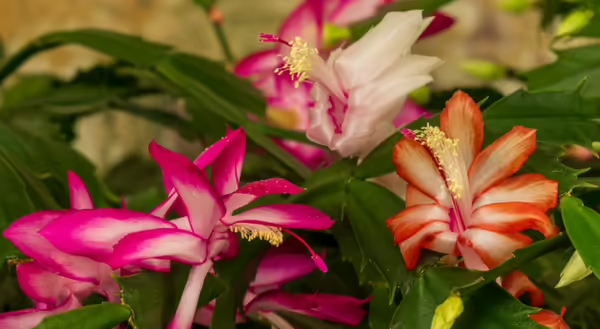
During the holiday season comes tasty food, festive decorations, and precious time spent with those dear to us. It also means an array of holiday plants in your home or office, like poinsettias, amaryllis, and holly. One plant that may not be on your holiday décor list, the holiday cactus, is a dependable and unique plant to consider purchasing or gifting this holiday season. With an element of flair, these faithful blooming plants will always unveil their timely gift of blooms for the holiday season.
Notable characteristics of the holiday cactus include flattened stem segments: Often referred to as leaves, these plant parts are known as phylloclades. Blooms on this exotic plant offer several weeks of dazzling color in strong single or blended hues of pink, white, red, and purple, depending on the hybrid or cultivar.
How do you tell if you have a Thanksgiving cactus (Schlumbergera truncata) or a Christmas cactus
(Schlumbergera x buckleyi)? The flattened stem segments are similarly shaped but display distinct characteristics. Examine the stem segment edges to distinguish each cactus: pointed serrations on Thanksgiving cacti, and slightly rounded edges on Christmas cacti.
This plant, native to Brazil, is an epiphyte that grows in rainforest tree branches with no attachment to the ground, and resources the air and rain for nutrients and moisture. With proper care, epiphytes can be long-lived houseplants in all parts of the world – including your home in our temperate zone. A good growing environment includes high humidity and bright filtered light when growing indoors. Waterlogged soils will quickly cause the roots to rot; water the cacti well when the soil is dry to the touch. Slightly pot-bound roots will encourage more blooms on the plant, so only repot to a bigger container every three years during the spring.
Holiday cacti are short-day plants, requiring an increased amount of natural darkness and cool temperatures to bloom. Six weeks of thirteen hours or more of darkness each night is required for the flower buds to develop. Any indoor or outdoor lights, even for a short amount of time, can disrupt this process and prevent flower development. Cool temperatures are also needed for the buds to develop; keep plants in a brightly lit space with a temperature of 60 to 68 degrees Fahrenheit for maximum flower development.
Following the holiday season, share cuttings of the stunning plant with envious family or friends. It is easily propagated in late spring by removing a 3-section part of the stem that is allowed to dry one day, to callous and prevent rotting. Plant in a small pot, 1” deep in potting soil to root. Roots should develop in 3-4 weeks. Spread joy and the tradition of holiday cacti by gifting your epiphyte in a decorative planter next holiday season.
Often passed down from generation to generation, you may have memories of a beloved friend or family member growing this fascinating and beloved plant in your childhood. As the holiday season approaches, skip the stress of selecting holiday décor, and cherish this time-honored centerpiece instead—a holiday jewel amongst houseplants.